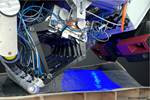Saint-Gobain, Roctool join efforts to boost composite 3D textile preform parts manufacturing
3D automated knitted preform layup technology and heat and cooling technologies for additional curing efficiency open a new window of application opportunities for composite and thermoplastic parts.

Photo Credit: Getty Images
Saint-Gobain Aerospace (Courbevoie, France) and Roctool SA’s (Le Bourget du Lac, France) site in Bordeaux, France, have joined efforts to offer fast composite or thermoplastic 3D textile preform parts manufacturing for a variety of applications and sectors such as mobility, energy, medical, military, communications, aerospace and marine.
According to Saint-Gobain, the 3D automated knitted preform layup technology it acquired in March 2018 enables the design of components with optimized performance and weight, while enhancing material usage. Moreover, it reportedly replaces time-consuming hand layup via rapid reproducible 3D net shape manufacturing. The final composite or thermoplastic part obtained with these preforms is then consolidated during cure through liquid thermoset resins or the incorporation thermoplastic reinforcement fibers during knitting.
In addition, to speed up the curing process (typically 5-10 hours), Roctool, a specialist in mold heating and cooling technologies for plastics and composites, developed a molding system that increased curing efficiency to 15-30 minutes for the polymerization of composite materials or the thermo-compression of thermoplastic parts, while increasing the production capacity of a single mold by a factor of 50. According to Roctool, the patented heat and cool layout provides a fast and homogeneous heating on the mold surface through flexible inductors run through by a high-frequency current, and efficient cooling by standard cooling channels with a fully turbulent water flow rate.
“The combination of these two technologies offers some of the highest manufacturing speed of today’s high-performance industries and definitely a new window of applications to our customers who need composite or thermoplastic parts,” Scott Huth, general manager for Saint-Gobain Aerospace, says. “At the same time, both technologies dramatically improve the environmental footprint. [For example], the knitting technology does not produce any waste (30% materials savings in average) and does not need any freezer to store the raw material (like in the conventional composite industry with prepregs stored during one year at -18°C). Also, the fast induction system saves up to 50% kilowatt-hours compared with a conventional oven cycle which would correspond to 50 tons of CO2 per production line.”
“We strongly believe that OEM and manufacturers need turnkey solutions to quickly respond to the market demands,” Mathieu Boulanger, CEO Roctool underlines. “Our exclusive collaboration with Saint-Gobain for specific market segments focus the efforts on one of the key players and is another good example of the importance of combining material technologies and processing methods.”
As a result of this association, Saint-Gobain’s facility at Saint Jean d’Illac (near Bordeaux, France), which manufacture composite parts for the aeronautical industry, will boost its business opportunities while developing new growth markets outside the aeronautical sector.
Related Content
-
Manufacturing the MFFD thermoplastic composite fuselage
Demonstrator’s upper, lower shells and assembly prove materials and new processes for lighter, cheaper and more sustainable high-rate future aircraft.
-
The state of recycled carbon fiber
As the need for carbon fiber rises, can recycling fill the gap?
-
PEEK vs. PEKK vs. PAEK and continuous compression molding
Suppliers of thermoplastics and carbon fiber chime in regarding PEEK vs. PEKK, and now PAEK, as well as in-situ consolidation — the supply chain for thermoplastic tape composites continues to evolve.















